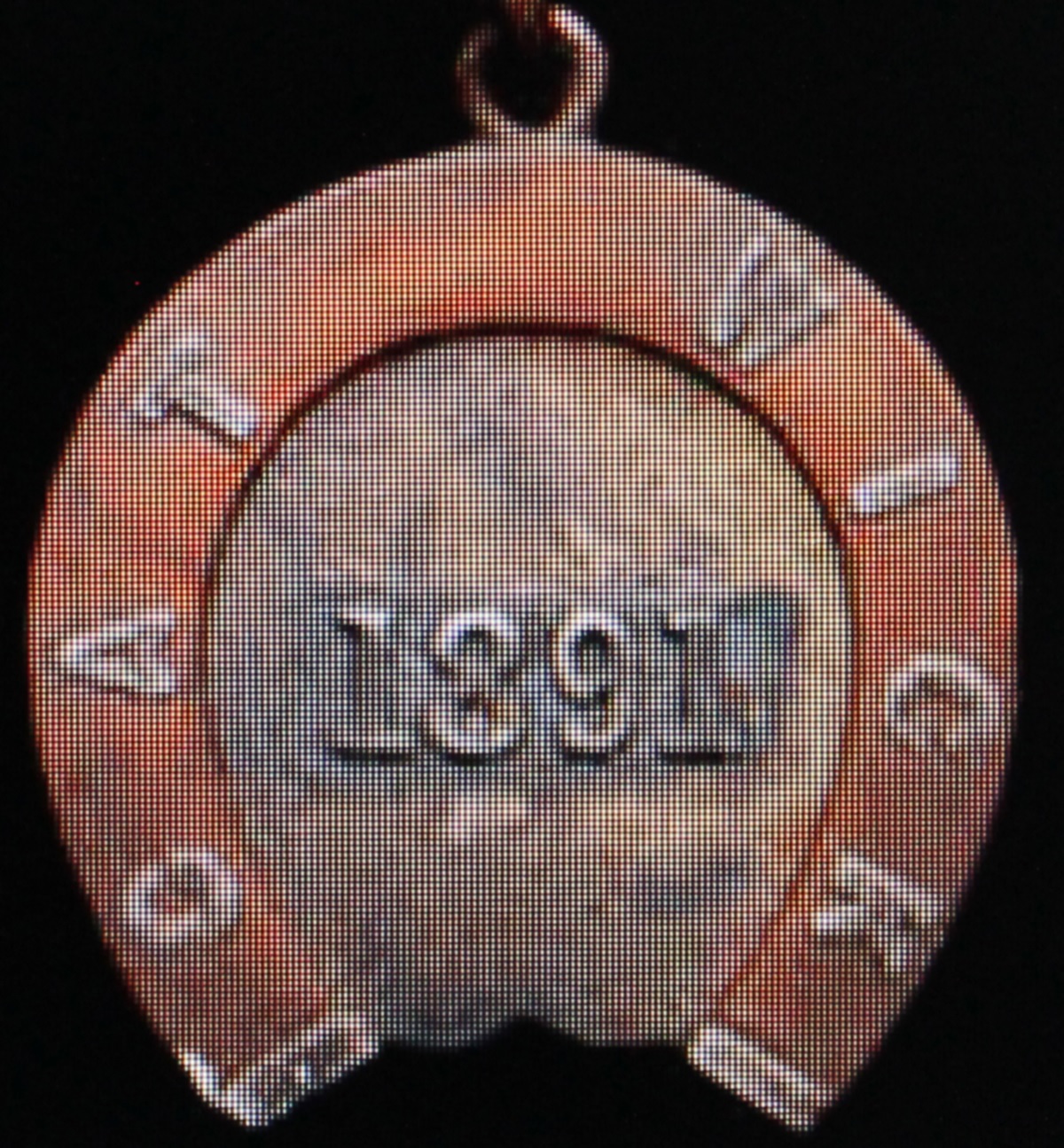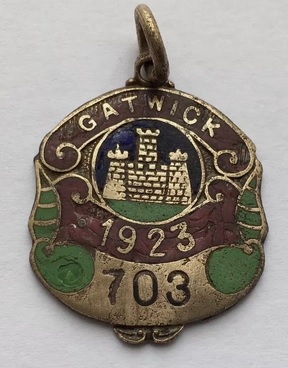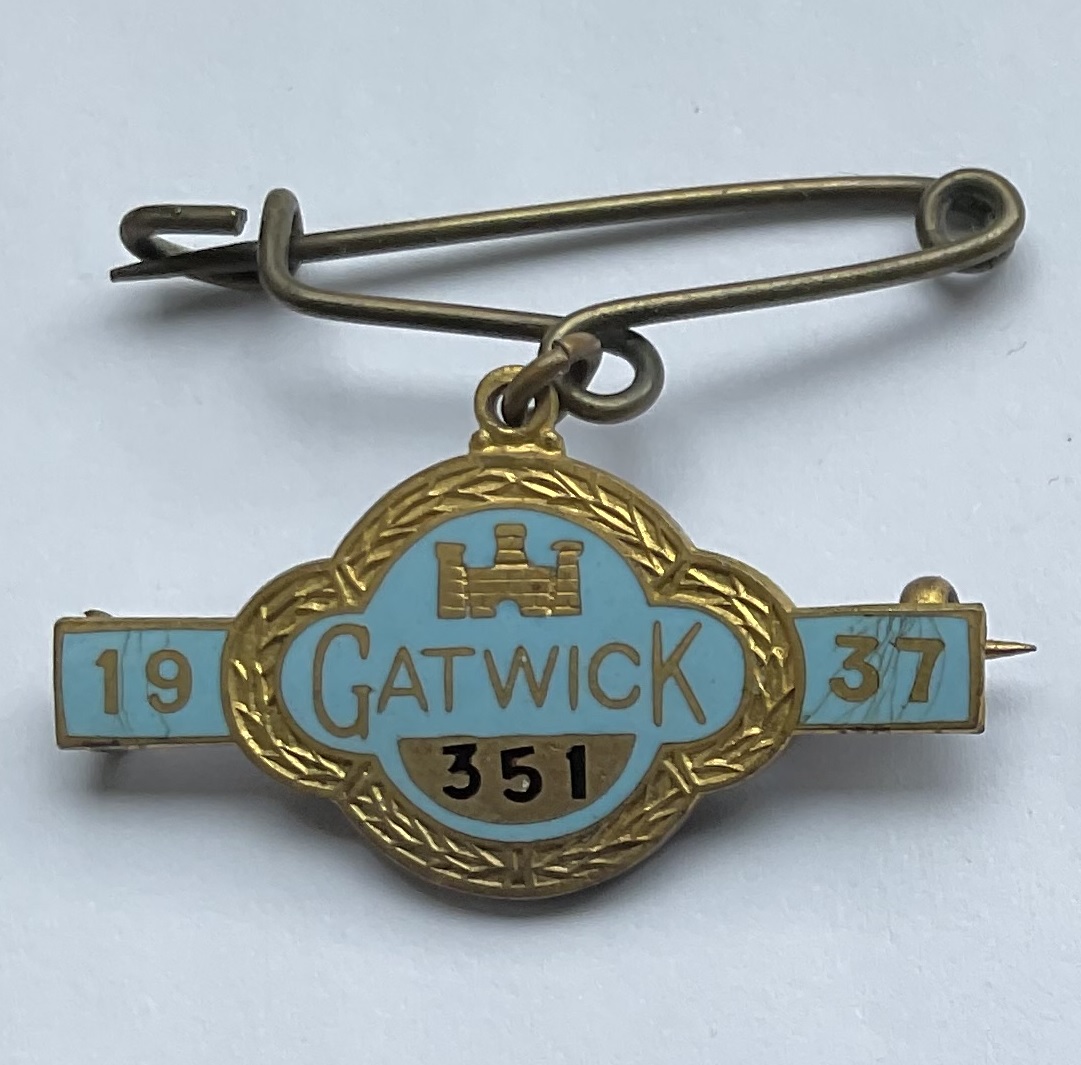Earliest meeting: Wednesday 7th October 1891
Final meeting: Saturday 15th June 1940
Much better known as an airport, the old Gatwick Racecourse was situated midway between London and Brighton and first opened for business on Wednesday 7th October 1891. The old Manor of Gatwick, and its surrounding estate, was owned by Mr John Farlow, and he sold it on 13th December 1890. The course was an oval of a mile and 7 furlongs with the slightest of inclines, and the main course joined the straight mile course with about 5 furlongs to the winning post. The Aintree Grand National was run at Gatwick on 3 occasions during the first World War. On Friday 24th March 1916 the Grand National was also called the ‘Race Course Association Steeplechase’ and saw Vermouth beat Irish Mail and Schoolmoney. The next year ‘The War National Steeplechase’ was held on Wednesday 21st March 1917 being won by Sir G Bullogh’s Ballymacad, getting the better of Chang and Ally Sloper. The final time Gatwick hosted the Grand National was on Thursday 21st March 1918 when Poethlyn was ridden to victory in the hands of E.Piggot for Mr Hugh Peel. Once War broke out in 1939 it was highly likely that the vast open space of Gatwick would be used by the military. A final two day National Hunt was staged on Wednesday 27th and Thursday 28th March 1940, while the final Flat race meeting took place on Friday 14th and Saturday 15th June 1940. The badge shown below is thought to be an 1891 Members badge.


Although Gatwick Racecourse was later replaced by the busy Gatwick Airport, some might question why the Racecourse came into being in the first place. Nearby Croydon had enjoyed their racecourse from 1826, but weather and poorly behaving crowds often blighted the meeting, so much so that in 1890 the County Council made it known that they would not renew the racecourse’s licence to race after the final meeting of 15th October 1890. In May 1890 the New Croydon Racecourse committee stated that they would have to vacate their site by December and were actively seeking a new site for their course. They bought a large portion of the Gatwick Estate, near Horley, with the intention of converting it into a brand new racecourse, and to erect stabling for up to 500 horses. Initially the Jockey Club refused the application to hold flat racing on the proposed new course, but by July 1890 they had reversed their decision. Many of the public complaints about building a new racecourse, particularly the increase in traffic, did not hold in this case because it was just a transfer of license from Croydon to Gatwick. Already, even at this early stage, the target was to hold a trial steeplechase meeting in March, and to stage the first proper meeting under Jockey Club rules in October 1891. In November 1890 Mr Stevens, of East Grinstead, was awarded the contract to erect the new iron and wood grandstand at Gatwick at a cost of £10,500, equivalent today to £1.4 million. Within a month the proprietors invited the Sporting Press, and other influential people closely connected to racing, a total of 40 people to inspect the new ground on which the racecourse was being built, the inspection meeting being organised by Mr G H Verrail who acted as President, and Mr Sotham who was Vice-President. At this point they could see the straight mile, an undulating mile long course of sufficient width for a large field to compete on equal terms. The circular steeplechase course was to be a mile and seven furlongs in circumference, the whole course being visible from the grandstand which was already under construction. The London, Brighton and South Coast Railway Company had given their blessing for the new course, agreeing to construct a new station ideally located at the rear of the grandstand, providing a direct service from London in less than an hour. A Gatwick Race Club was formed, headed by the famous racehorse owner Captain Machell, membership of which provided the badge holders with reserved access to the Members Stand. Although it was doubtful in December 1890 that the course would be ready for an initial trial meeting on 3rd and 4th March 1891, it was still hoped that there could be a gathering on 23rd and 24th April for a meeting under Jockey Club Rules.
By early October 1891 the new racecourse at Gatwick was ready to launch its first two-day meeting on Wednesday 7th and Thursday 8th October 1891. The Sporting Life commented, ‘Considering the persistent rain of Tuesday and the overnight prospects of more rain, under the circumstances the inaugural meeting at Gatwick was more favourable than could have been anticipated. Although the morning was unpropitious, the weather cleared up by noon, and no rain fell during racing. The opening of the new course resembles much the first night of a play, when absolute readiness can only be achieved by practice. A few small details were overlooked, some of the new machinery did not work, but there was not much with which to find fault with the Gatwick administrators. Everyone admired the actual racecourse and its surroundings, with the enclosure voted as the prettiest seen by any racegoer. What it will be like on a glorious summer day must be left to the imagination; music, flowers, delicious promenades and everything to please is so closely associated with our noble pastime as to make one think that, in spite of a good opening, there may be still better days to come’.
Wednesday 7th October 1891
The Autumn Stakes 200 Sovereigns over 1 mile
1. WHISPERER (8/15 fav) owned by Mr Harry McCalmont and ridden by George Chaloner
2. BRANDY (9/2) owned by Colonel North and ridden by Mornington Cannon
3. REFORMATION (100/12) owned by Mr H Cox and ridden by G Barrett
The Surrey Nursery 200 soevreigns over 5 furlongs
1. QUEEN OF THE FLORIN (11/2) owned by Mr J Joicey and ridden by Fred Rickaby
2. NAVARRO (2/1 fav) owned by Lord Lurgan and ridden by John Watts
3. ORONTES (5/1) owned by Mr Tom Jennings and ridden by Mornington Cannon
The Horley Handicap 300 sovereigns over a one mile straight
1. INVERKEITHING (100/14) owned by Mr G Ryall and ridden by J J Griffiths
2. TUDOR (85/20) owned by Mr W G Stevens and ridden by George Chaloner
3. RAMELTON LASSIE (9/2) owned by Mr J Joicey and ridden by R Chaloner
The Charlwood Handicap over 5 furlongs
1. ADMIRAL BENBOW (5/2 fav) owned by Mr J B Burton and ridden by G Barrett
2. HIATUS (9/2) owned by R Chaloner and ridden by Mr A Taylor
3. SIR FREDERICK ROBERTS (4/1) owned by Colonel North and ridden by Jimmy Woodburn
The Mole Stakes 200 sovereigns over 6 furlongs
1. ERNEST (10/1) owned by Mr W Blake and ridden by Fred Rickaby
2. PEACEMAKER (3/1 jt fav) owned by Mr Gottenhall and ridden by Mornington Cannon
3. NIAGARA (6/1) owned by Mr Abington and ridden by F Barrett
The Rothschild Stakes 200 sovereigns over one and a half miles
1. HALSBURY (2/9 fav) owned by Mr Abington and ridden by George Chaloner
2. DRUMLINA (5/1) owned by Mr Egremont and ridden by R Chaloner
3. MAPLE (20/1) owned and ridden by Mr R Williamson
Thursday 8th October 1891
The Redhill Welter Handicap 200 sovereigns
1. SORCERESSE (6/1) owned by Mr Abington and ridden by F Barrett
2. DEVILIN (3/1) owned by Mr T Sharpe and ridden by Fred Rickaby
3. ODDFELLOW (11/8 fav) owned by Mr F Luscombe and ridden by John Watts
The Ifield Stakes 200 sovereigns
1. ANCAJANO (2/1 fav) owned by Mr S Nesbitt and ridden by R Chaloner
2. SEA WAVE (100/30) owned by Mr W Burton and ridden by G Barrett
3. CHARLESTON (6/1) owned by Mr Kemp and ridden by Fred Rickaby
The Gatwick Handicap 300 sovereigns
1. CATARINA (5/1) owned by Mr Tom Jennings and ridden by H Harper
2. INVERKEITHING (9/4) owned by Mr G Ryall and ridden by J J Griffiths
3. VASISTAS (4/1) owned by Baron de Hirsch and ridden by G Barrett
The Crawter Stakes 200 sovereigns
1. EDWARD THE CONFESSOR Colt (7/2) owned by Baron M D Tuyll and ridden by Mornington Cannon
2. WHORTLEBERRY (2/1 fav) owned by Captain Machell and ridden by George Chaloner
3. WEYMOUTH (100/6) owned and ridden by Mr Robinson
The Montifore Stakes 300 sovereigns
1. PALISANDRE (7/4) owned by Lord Gerard and ridden by George Chaloner
2. THE REJECTED (11/10 fav) owned by Mr J O’Neill and ridden by Fred Rickaby
3. INSURANCE (9/2) owned by Mr C P Shrubb and ridden by Mornington Cannon
The Lowfield Nursery 200 sovereigns
1. SANTA ROSA (6/1) owned by Mr C P Cunliffe and ridden by Cartledge
2. BRAEMAR (5/1) owned by Mr Chaddleworth and ridden by R Chaloner
3. REFORMATION (20/1) owned by Mr Harding Cox and ridden by C Chaloner
The Champagne Plate over a mile and 7 furlongs
1. Chasuble owned by Mr William Johnston
2. Spook owned by Mr D E Higham
3. Tyro owned by Mr W Blake
The Alexandra Handicap over 6 furlongs
1. Berzak owned by Lord W Beresford
2. Saint Noel owned by Mr J Tyler
3. Northern Farmer owned by Mr Horatio Bottomley
The Prince’s Handicap over 1 ½ miles
1. Lord Edward II owned by Mr H V Long
2. Jiffy II owned by Lord W Beresford
3. Morningdew owned by Mr Houldsworth

I am grateful to Bill Haylor for the scan shown below. Does anyone know when the card was produced, which house on the outskirts of Gatwick is pictured, and what the original inscriptions were on the card?

Thursday 21st March 1918
Gatwick Grand National
1. Poethlyn, owned by Mrs Hugh Peel and ridden by E.Piggot
2. Captain Dreyfus, owned by Mr F R Hunt and ridden by J Reardon
3. Ballymacad, owned by Sir G Bullough and ridden by I Anthony

The rare handbill shown below is provided courtesy of the Robert Shaw collection.

The front cover/ principal races from this rare racecard are provided courtesy of the Robert Shaw collection.


Much of the information about this course has been found using internet research and is in the public domain. However, useful research sources have been:-
London Illustrated News
Racing Illustrated 1895-1899
The Sporting & Dramatic Illustrated
Northern Turf History Volumes 1-4 by J.Fairfax-Blakeborough
The Sporting Magazine
A Long Time Gone by Chris Pitt first published in 1996 ISBN 0 900599 89 8
Racing Calendars which were first published in 1727
















